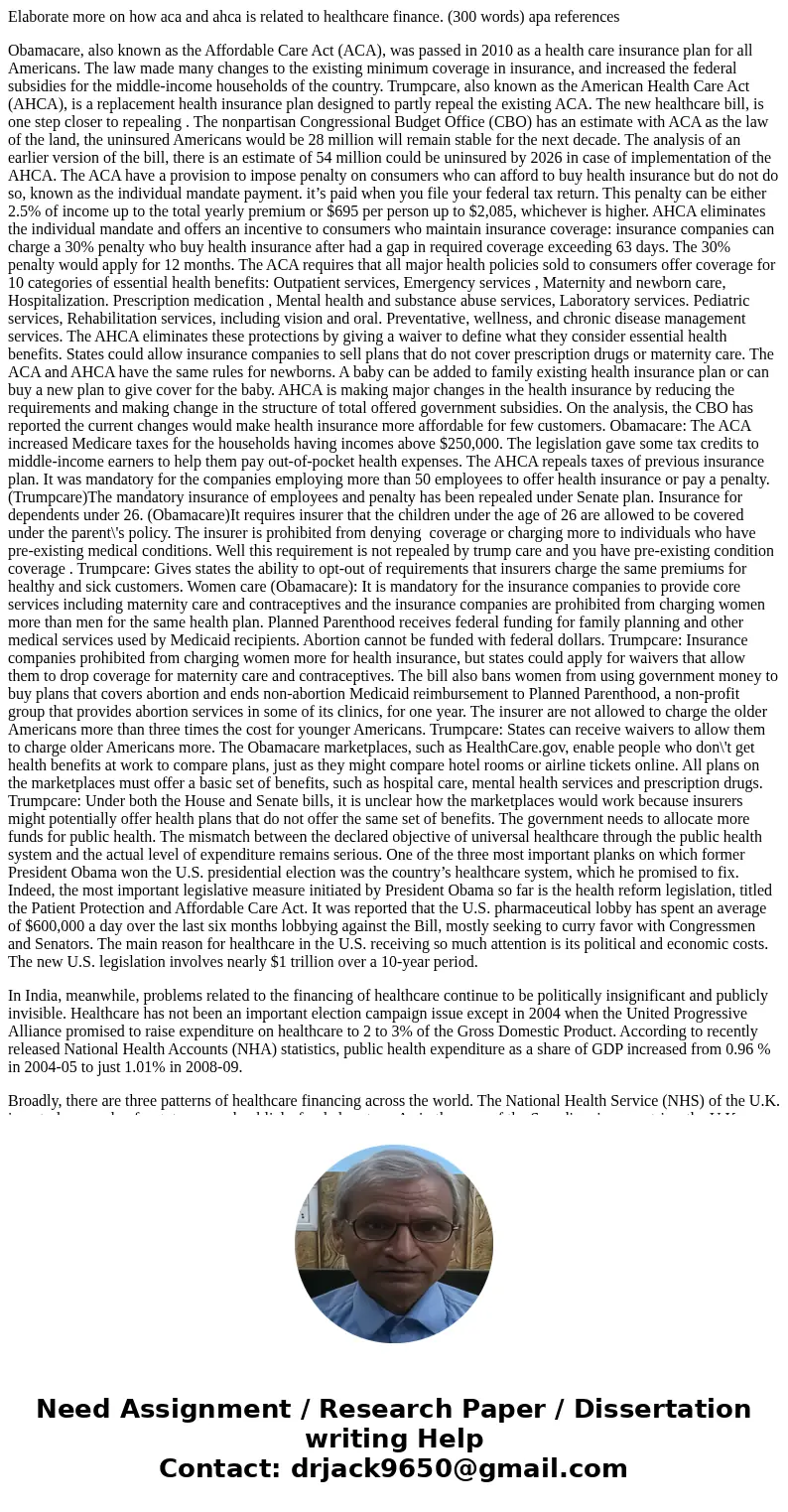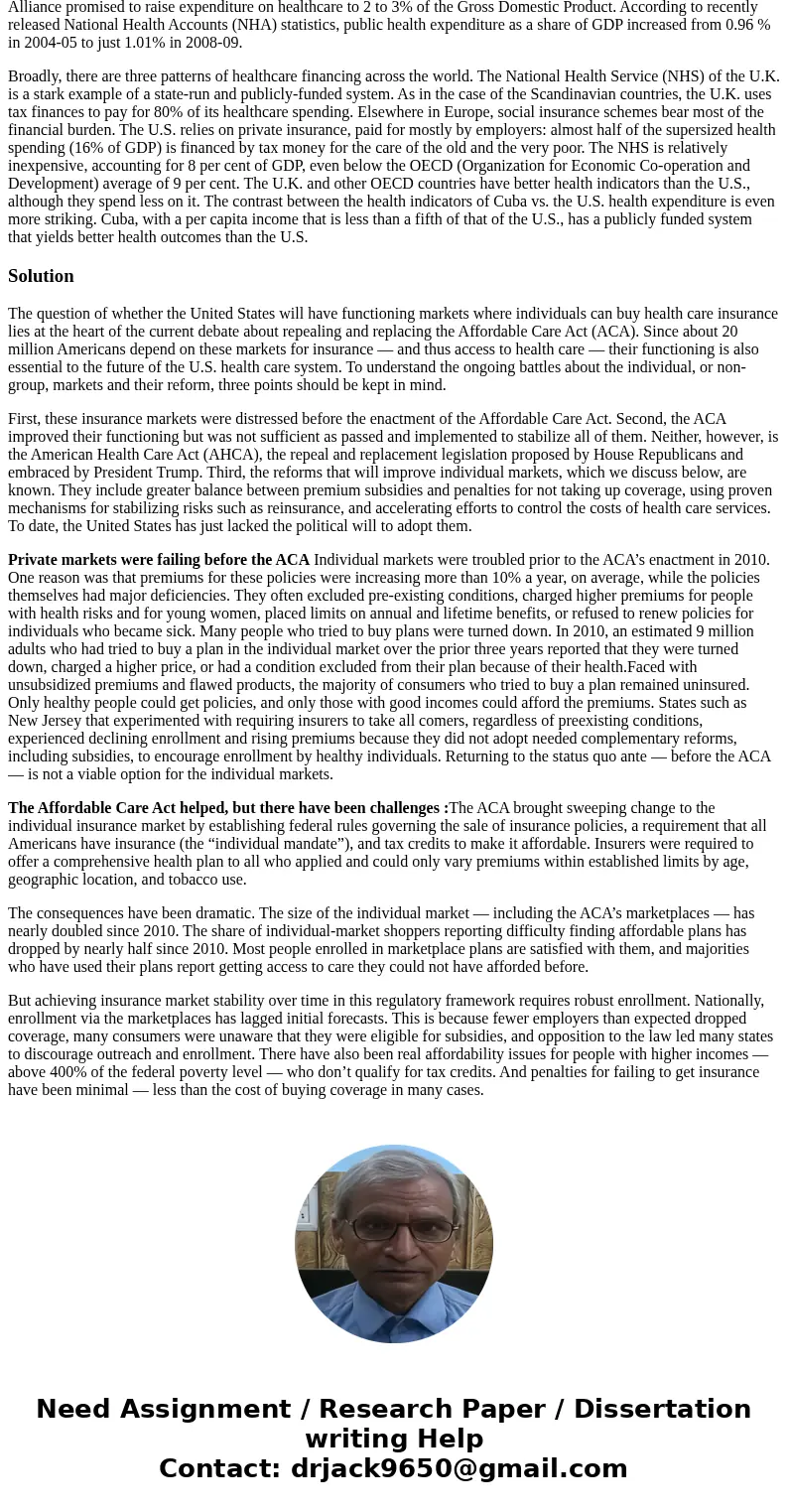Elaborate more on how aca and ahca is related to healthcare
Elaborate more on how aca and ahca is related to healthcare finance. (300 words) apa references
Obamacare, also known as the Affordable Care Act (ACA), was passed in 2010 as a health care insurance plan for all Americans. The law made many changes to the existing minimum coverage in insurance, and increased the federal subsidies for the middle-income households of the country. Trumpcare, also known as the American Health Care Act (AHCA), is a replacement health insurance plan designed to partly repeal the existing ACA. The new healthcare bill, is one step closer to repealing . The nonpartisan Congressional Budget Office (CBO) has an estimate with ACA as the law of the land, the uninsured Americans would be 28 million will remain stable for the next decade. The analysis of an earlier version of the bill, there is an estimate of 54 million could be uninsured by 2026 in case of implementation of the AHCA. The ACA have a provision to impose penalty on consumers who can afford to buy health insurance but do not do so, known as the individual mandate payment. it’s paid when you file your federal tax return. This penalty can be either 2.5% of income up to the total yearly premium or $695 per person up to $2,085, whichever is higher. AHCA eliminates the individual mandate and offers an incentive to consumers who maintain insurance coverage: insurance companies can charge a 30% penalty who buy health insurance after had a gap in required coverage exceeding 63 days. The 30% penalty would apply for 12 months. The ACA requires that all major health policies sold to consumers offer coverage for 10 categories of essential health benefits: Outpatient services, Emergency services , Maternity and newborn care, Hospitalization. Prescription medication , Mental health and substance abuse services, Laboratory services. Pediatric services, Rehabilitation services, including vision and oral. Preventative, wellness, and chronic disease management services. The AHCA eliminates these protections by giving a waiver to define what they consider essential health benefits. States could allow insurance companies to sell plans that do not cover prescription drugs or maternity care. The ACA and AHCA have the same rules for newborns. A baby can be added to family existing health insurance plan or can buy a new plan to give cover for the baby. AHCA is making major changes in the health insurance by reducing the requirements and making change in the structure of total offered government subsidies. On the analysis, the CBO has reported the current changes would make health insurance more affordable for few customers. Obamacare: The ACA increased Medicare taxes for the households having incomes above $250,000. The legislation gave some tax credits to middle-income earners to help them pay out-of-pocket health expenses. The AHCA repeals taxes of previous insurance plan. It was mandatory for the companies employing more than 50 employees to offer health insurance or pay a penalty. (Trumpcare)The mandatory insurance of employees and penalty has been repealed under Senate plan. Insurance for dependents under 26. (Obamacare)It requires insurer that the children under the age of 26 are allowed to be covered under the parent\'s policy. The insurer is prohibited from denying coverage or charging more to individuals who have pre-existing medical conditions. Well this requirement is not repealed by trump care and you have pre-existing condition coverage . Trumpcare: Gives states the ability to opt-out of requirements that insurers charge the same premiums for healthy and sick customers. Women care (Obamacare): It is mandatory for the insurance companies to provide core services including maternity care and contraceptives and the insurance companies are prohibited from charging women more than men for the same health plan. Planned Parenthood receives federal funding for family planning and other medical services used by Medicaid recipients. Abortion cannot be funded with federal dollars. Trumpcare: Insurance companies prohibited from charging women more for health insurance, but states could apply for waivers that allow them to drop coverage for maternity care and contraceptives. The bill also bans women from using government money to buy plans that covers abortion and ends non-abortion Medicaid reimbursement to Planned Parenthood, a non-profit group that provides abortion services in some of its clinics, for one year. The insurer are not allowed to charge the older Americans more than three times the cost for younger Americans. Trumpcare: States can receive waivers to allow them to charge older Americans more. The Obamacare marketplaces, such as HealthCare.gov, enable people who don\'t get health benefits at work to compare plans, just as they might compare hotel rooms or airline tickets online. All plans on the marketplaces must offer a basic set of benefits, such as hospital care, mental health services and prescription drugs. Trumpcare: Under both the House and Senate bills, it is unclear how the marketplaces would work because insurers might potentially offer health plans that do not offer the same set of benefits. The government needs to allocate more funds for public health. The mismatch between the declared objective of universal healthcare through the public health system and the actual level of expenditure remains serious. One of the three most important planks on which former President Obama won the U.S. presidential election was the country’s healthcare system, which he promised to fix. Indeed, the most important legislative measure initiated by President Obama so far is the health reform legislation, titled the Patient Protection and Affordable Care Act. It was reported that the U.S. pharmaceutical lobby has spent an average of $600,000 a day over the last six months lobbying against the Bill, mostly seeking to curry favor with Congressmen and Senators. The main reason for healthcare in the U.S. receiving so much attention is its political and economic costs. The new U.S. legislation involves nearly $1 trillion over a 10-year period.
In India, meanwhile, problems related to the financing of healthcare continue to be politically insignificant and publicly invisible. Healthcare has not been an important election campaign issue except in 2004 when the United Progressive Alliance promised to raise expenditure on healthcare to 2 to 3% of the Gross Domestic Product. According to recently released National Health Accounts (NHA) statistics, public health expenditure as a share of GDP increased from 0.96 % in 2004-05 to just 1.01% in 2008-09.
Broadly, there are three patterns of healthcare financing across the world. The National Health Service (NHS) of the U.K. is a stark example of a state-run and publicly-funded system. As in the case of the Scandinavian countries, the U.K. uses tax finances to pay for 80% of its healthcare spending. Elsewhere in Europe, social insurance schemes bear most of the financial burden. The U.S. relies on private insurance, paid for mostly by employers: almost half of the supersized health spending (16% of GDP) is financed by tax money for the care of the old and the very poor. The NHS is relatively inexpensive, accounting for 8 per cent of GDP, even below the OECD (Organization for Economic Co-operation and Development) average of 9 per cent. The U.K. and other OECD countries have better health indicators than the U.S., although they spend less on it. The contrast between the health indicators of Cuba vs. the U.S. health expenditure is even more striking. Cuba, with a per capita income that is less than a fifth of that of the U.S., has a publicly funded system that yields better health outcomes than the U.S.
Solution
The question of whether the United States will have functioning markets where individuals can buy health care insurance lies at the heart of the current debate about repealing and replacing the Affordable Care Act (ACA). Since about 20 million Americans depend on these markets for insurance — and thus access to health care — their functioning is also essential to the future of the U.S. health care system. To understand the ongoing battles about the individual, or non-group, markets and their reform, three points should be kept in mind.
First, these insurance markets were distressed before the enactment of the Affordable Care Act. Second, the ACA improved their functioning but was not sufficient as passed and implemented to stabilize all of them. Neither, however, is the American Health Care Act (AHCA), the repeal and replacement legislation proposed by House Republicans and embraced by President Trump. Third, the reforms that will improve individual markets, which we discuss below, are known. They include greater balance between premium subsidies and penalties for not taking up coverage, using proven mechanisms for stabilizing risks such as reinsurance, and accelerating efforts to control the costs of health care services. To date, the United States has just lacked the political will to adopt them.
Private markets were failing before the ACA Individual markets were troubled prior to the ACA’s enactment in 2010. One reason was that premiums for these policies were increasing more than 10% a year, on average, while the policies themselves had major deficiencies. They often excluded pre-existing conditions, charged higher premiums for people with health risks and for young women, placed limits on annual and lifetime benefits, or refused to renew policies for individuals who became sick. Many people who tried to buy plans were turned down. In 2010, an estimated 9 million adults who had tried to buy a plan in the individual market over the prior three years reported that they were turned down, charged a higher price, or had a condition excluded from their plan because of their health.Faced with unsubsidized premiums and flawed products, the majority of consumers who tried to buy a plan remained uninsured. Only healthy people could get policies, and only those with good incomes could afford the premiums. States such as New Jersey that experimented with requiring insurers to take all comers, regardless of preexisting conditions, experienced declining enrollment and rising premiums because they did not adopt needed complementary reforms, including subsidies, to encourage enrollment by healthy individuals. Returning to the status quo ante — before the ACA — is not a viable option for the individual markets.
The Affordable Care Act helped, but there have been challenges :The ACA brought sweeping change to the individual insurance market by establishing federal rules governing the sale of insurance policies, a requirement that all Americans have insurance (the “individual mandate”), and tax credits to make it affordable. Insurers were required to offer a comprehensive health plan to all who applied and could only vary premiums within established limits by age, geographic location, and tobacco use.
The consequences have been dramatic. The size of the individual market — including the ACA’s marketplaces — has nearly doubled since 2010. The share of individual-market shoppers reporting difficulty finding affordable plans has dropped by nearly half since 2010. Most people enrolled in marketplace plans are satisfied with them, and majorities who have used their plans report getting access to care they could not have afforded before.
But achieving insurance market stability over time in this regulatory framework requires robust enrollment. Nationally, enrollment via the marketplaces has lagged initial forecasts. This is because fewer employers than expected dropped coverage, many consumers were unaware that they were eligible for subsidies, and opposition to the law led many states to discourage outreach and enrollment. There have also been real affordability issues for people with higher incomes — above 400% of the federal poverty level — who don’t qualify for tax credits. And penalties for failing to get insurance have been minimal — less than the cost of buying coverage in many cases.


 Homework Sourse
Homework Sourse